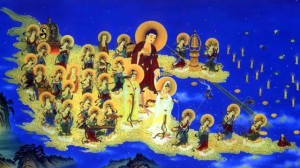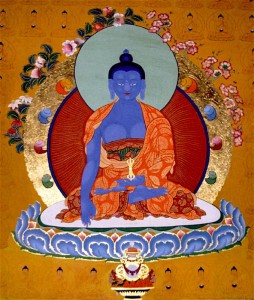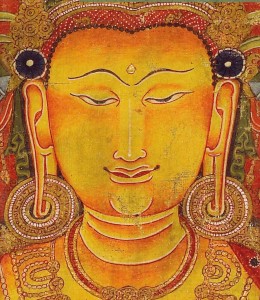The five Dhyani Buddhas – Buddhas in meditation
Dhyani Buddhas
This article about Dhyani Buddhas is part of the series about Indian spiritual mythology by Julian Millane
Dhyani Buddhas are emanated from Adibuddha. There are five Dhyani Buddhas (Buddhas in meditation). They are not separate deities – just abstract aspects of Buddhahood. They are also often called Tathagata.
They found in every stupa and found painted in Buddhist houses in Nepal.
They are also known as Panch Buddhas and are always shown seated in meditation posture. Of the five Dhyani Buddhas the senior is Vairocana, who occupies centre of the mandala.
In the chaityas (small stupas) only four others are depicted – Akshobya in the east, Ratna Sambhav in the south, Amithaba in the west and Amogsidhi in the north.
Vairocana
Vairocana, according to Hindu mythology, was an Asura (a being with divine powers). Vairocana appears in Buddhist teaching as the principal of the five Dhyani Buddhas.
He is said to be the personification of the Absolute, and is sometimes regarded as a type of Adibuddha or primordial Buddha.
In Tibet, the snow-lion is regarded as his mount. His colour is white and he is often seen holding a disc.
Vairocana is sometimes said to have introduced humankind to the Yogacara school of Mahayana or “Great Vehicle” Buddhism which teaches that everything is “mind only” and that the disciple’s aim is to achieve mystical union with the divine.
Amitabha
Amitabha is one of the most important buddhas of Mahayana. His name means “Boundless Light” or “He Whose Splendour is Immeasurable”.
Amithaba rules over the western paradise, a state of consciousness known as Sukhavati.
He is a type of saviour who assures people of a life after death: individuals are able to achieve liberation through calling on his name, rather than having to endure countless rebirths.
In a previous existence, Amitabha was a king who, after encountering the Buddhist teaching, gave up his throne to become the monk, Dharmakara.
The buddha is thus sometimes depicted with a shaven head.
Dharmakara took 48 vows in which he promised to help all those who attempted to tread the path towards enlightenment.
Through meditation, the monk eventually fulfilled his vows and became the buddha Amitabha.
His element is water, and he is associated with the twilight and life in the beyond.
He is usually shown as red in colour, sitting on a lotus blossom, although sometimes he is depicted riding a pair of peacocks.
Although he originated in India, Amitabha achieved his greatest popularity in China and Japan, where he is known as Amida.
The great Indian monk, Padmasambhava, who inspired the “Pure Land” school of Buddhism, introduced Amitabha’s culture to Tibet and it spread to Nepal.
Amitabha is often in Yab-yum, the posture of embrace, with his Shakti, Pandara.
Aksobhya
Aksobhya rules over the eastern paradise, Abhirati. His name means “Immovable”, and he is said to subjugate the passions and enjoy mirror-like wisdom.
Long ago, when Aksobhya was a monk he vowed before the buddha who then ruled over Abhirati that he would never experience anger or repulsion.
After endlessly striving to achieve this goal, he finally became a buddha and took up rulership over Abhirati.
Anyone who is reborn in Abhirati will never fall into lower levels of consciousness, so all disciples, like Aksobhya, seek to conquer passion. In Tibet, Aksobhya is represented as Gautuma Buddha.
He is usually depicted as blue in colour, and is sometimes shown supported by a blue elephant.
His main attribute is the thunderbolt and he is associated with the elephant. His Shakti, or corresponding female energy is Locana.
Aksobhya emanates the Bodhisattva Manjushri, the patron of kings of Tibet.
Ratna Sambhava
Ratna Sambhava is “The Source of Secret Things” and “He Who Is Born of the Jewel”.
In Tibet he is often shown embracing Mamaki, his Shakti.
His element is fire, his heavenly quarter the south, and he is yellow in colour. His carriage is drawn by a pair of lions, or a horse
Amoghasiddhi
Amoghasiddhi presides over the paradise of the north, and his name means “He Whose Accomplishment is not In Vain”.
He is sometimes identified with Gautama Buddha and is normally coloured green.
In Tibet he is sometimes shown in Yab-yum with Aryatara. The buddha sometimes sits on the throne decorated with eagle-like mythological birds.
He may hold a sword in one hand and make the gesture of “fear-not” with the other.
Amoghasiddhi’s element is the earth, and he is associated with the future buddha, Maitreya. Originally published in Here & Now magazine.
Written by Khalid Julian Millane, joint owner of Shikara Design, importer of Asian artifacts, furniture and carpets, and who has an endless fascination with Eastern mythology and history.
Share Dhyani Buddhas with your friends on Facebook





